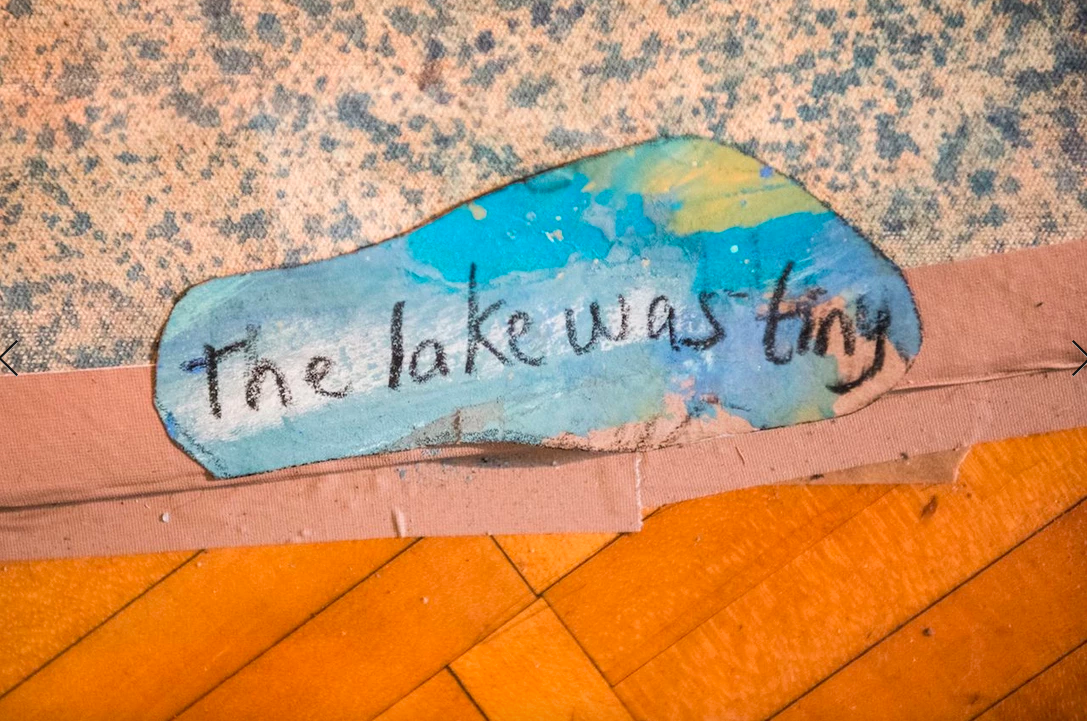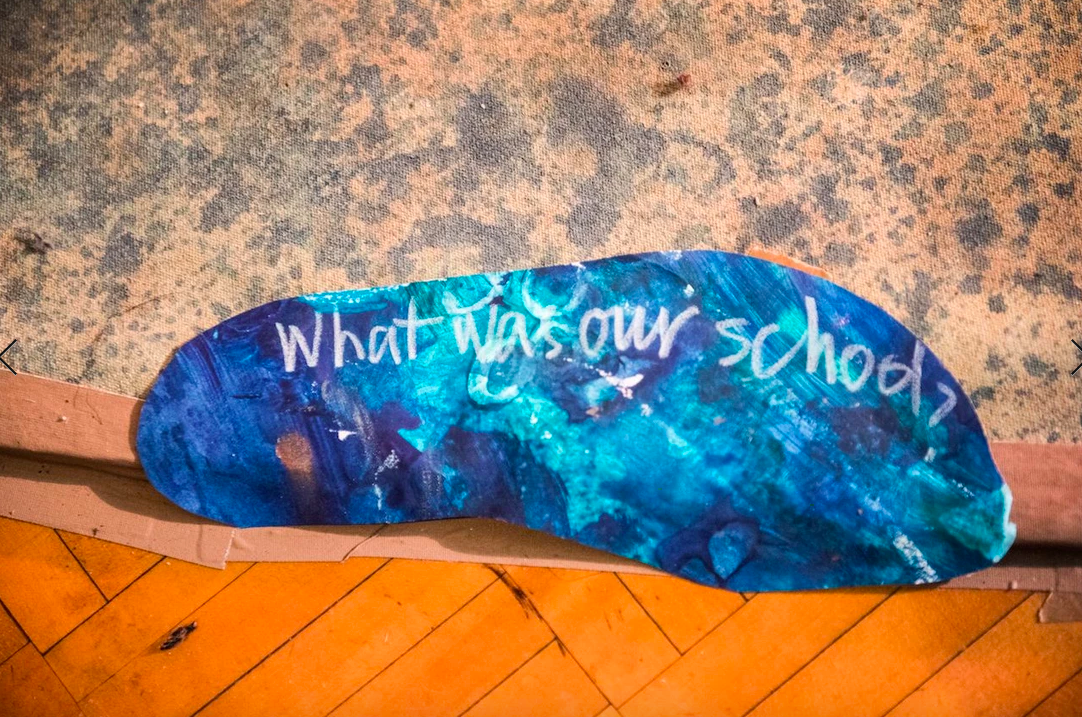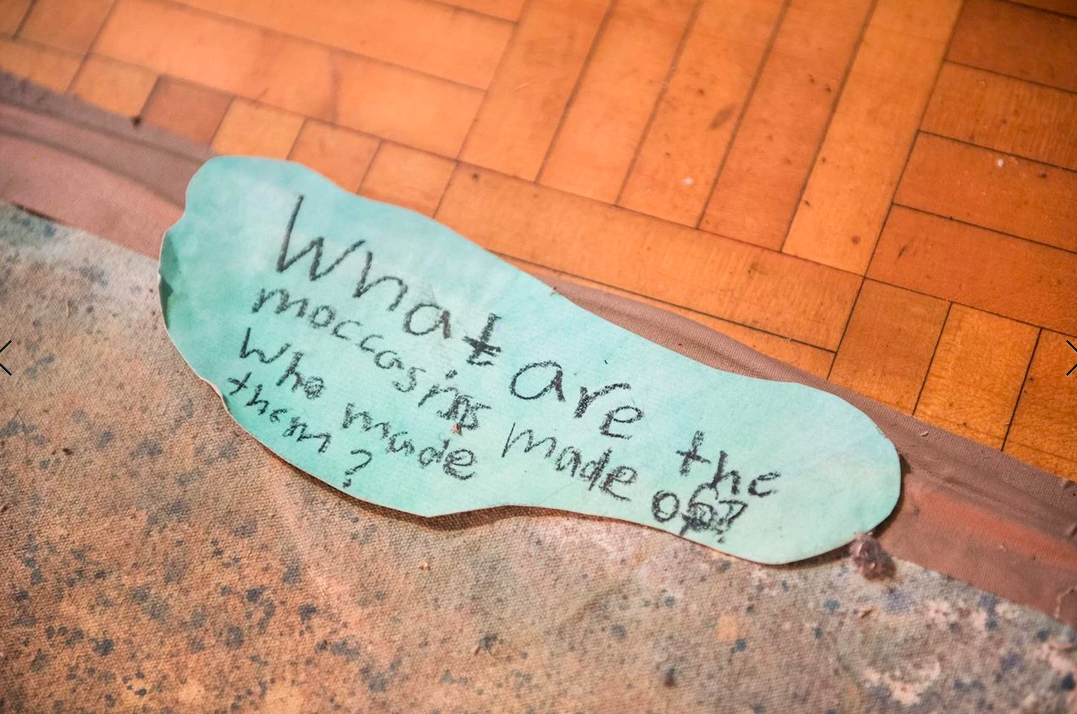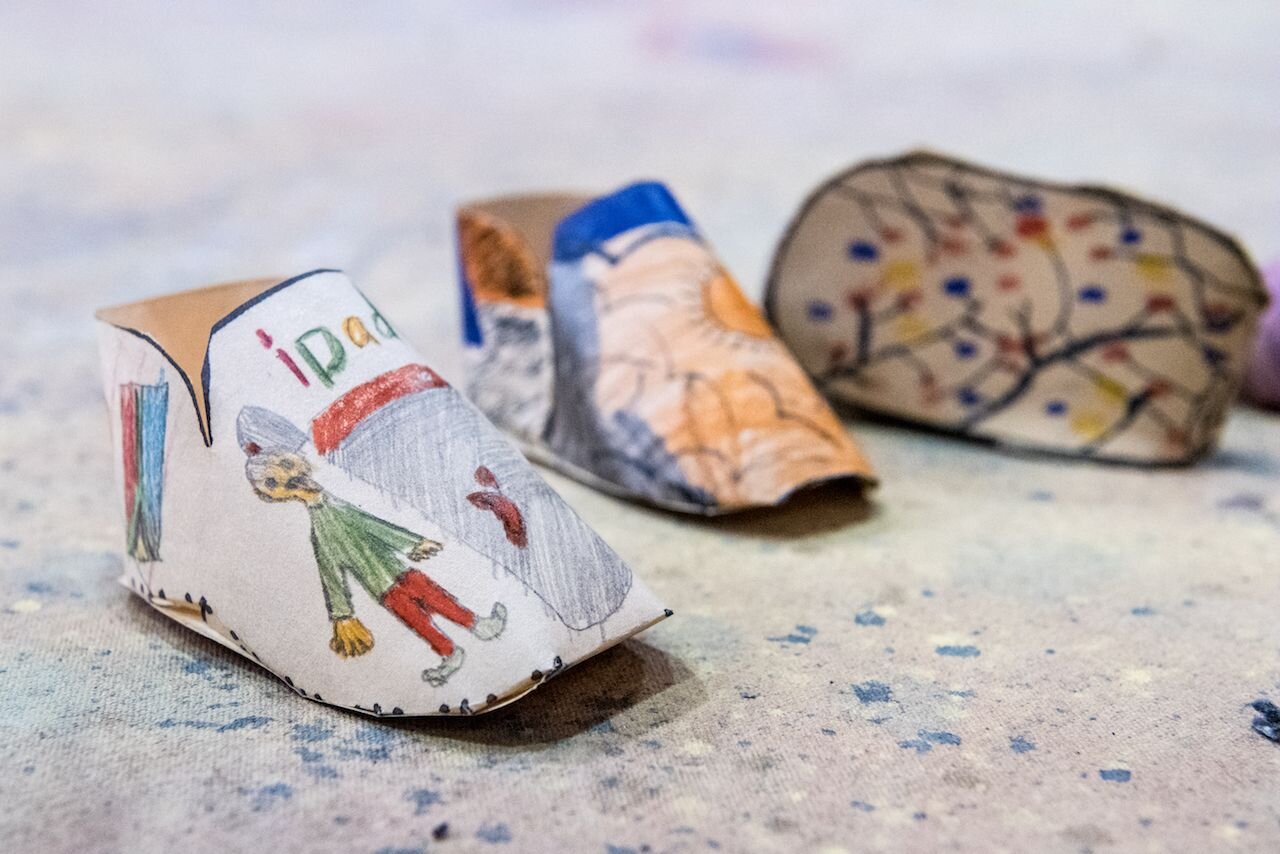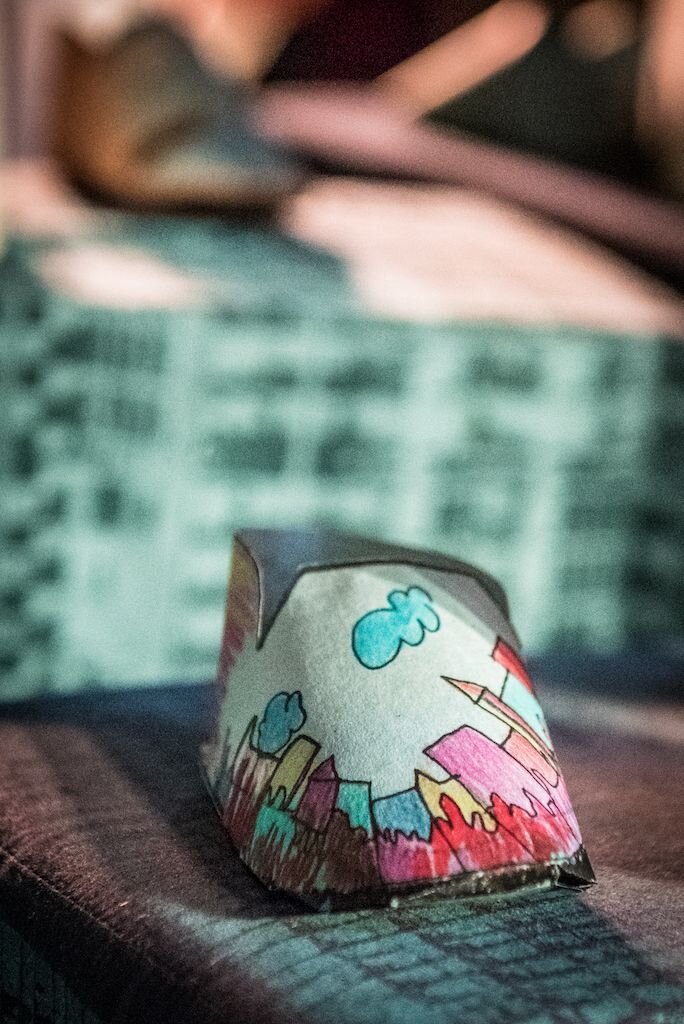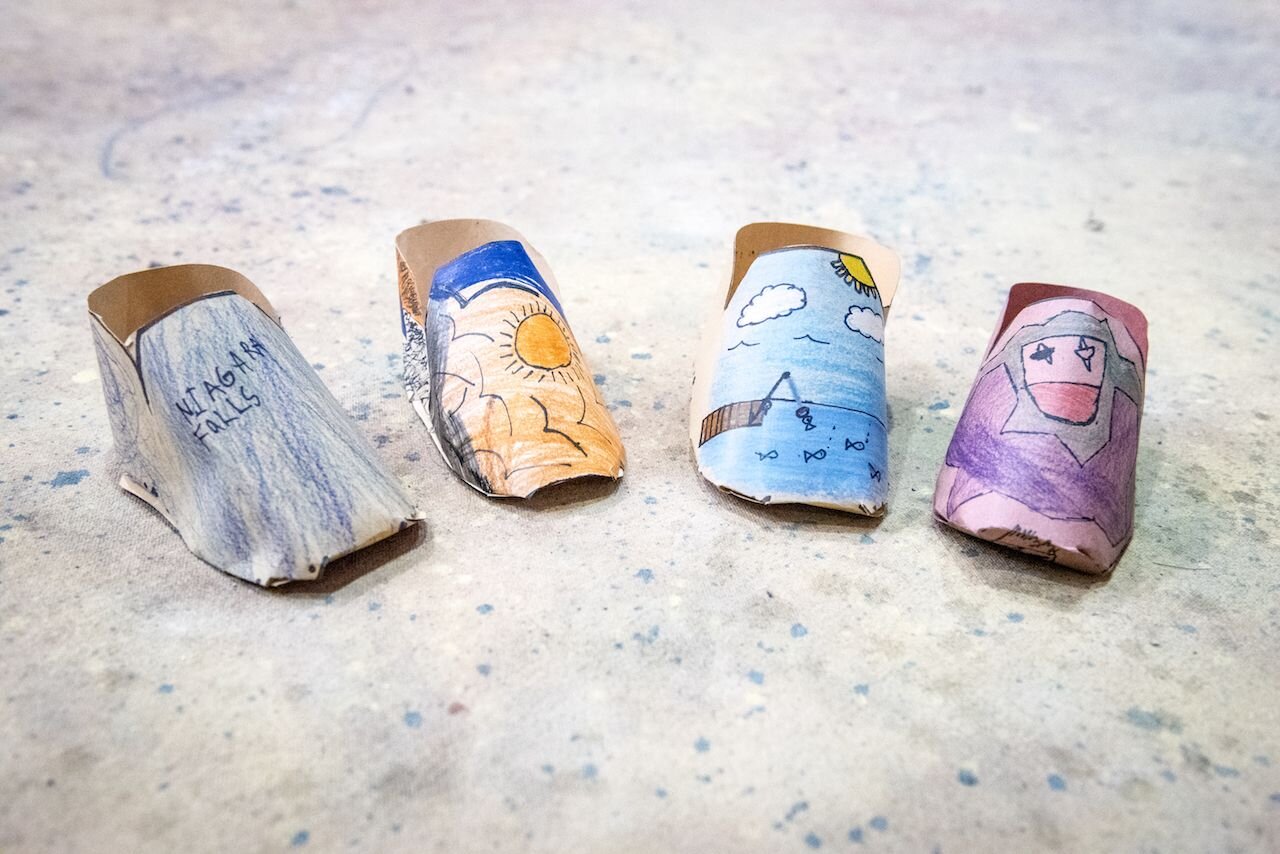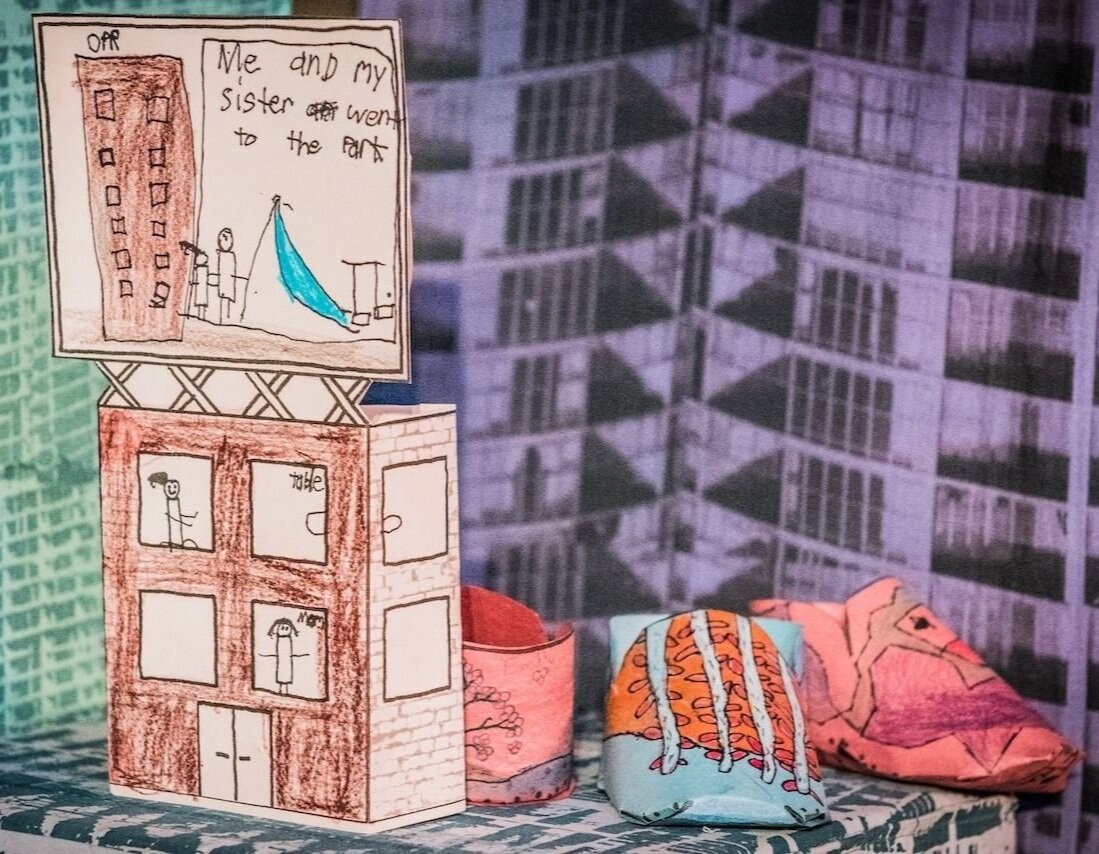Side by side: art education learnings & considerations
Placement Update
Towards the end of January, I joined the full artistic team on a Wednesday morning at a TDSB school. In the hours leading up to lunchtime, I volunteered to support the project’s introductory workshop, in the school gym, during which 80 grade 5/6’s were introduced to the stories and themes behind What Was My Backyard? Performing in the round to an audience of students, teachers and artists Artist Ange Loft shared the historical story that inspired the show.
For context, here is a (very brief) version of that story, with text adapted by the What Was My Backyard? artistic team from newspaper articles, blogs and other sources:
"11,000 years ago the entire Toronto area was a vast plain of tundra and spruce forest.
At one point, it seems a family walked north up from that smaller lake toward what’s now downtown Toronto. They were wearing moccasins, and for at least a few steps, they walked through blue clay, leaving their footprints behind.
Over the next few thousand years, the lake gradually grew, until it became the Lake Ontario we know today. And those 100 footprints, captured in that clay, were hidden from view. That is, until 1908 when workers installing a water pipe, 70 ft underwater just east of Hanlan’s Point discovered them.
'It looked like a trail,' a city inspector told the newspaper. 'You could follow one person the whole way. Some footprints were on top of the others. There were footprints of all sizes, and a single print of a child’s foot, about 3 inches long'
But the city was in a rush. They wanted to build a tunnel and they didn’t want to slow down. So they just poured concrete over the prints and kept going.
But somebody told the newspaper, the newspaper wrote about it. More than 100 years later, somebody read that old newspaper and wrote more about it, somebody else read that, put it in a presentation and told us about it, and so now we’re telling it to you. Bringing those footprints into to this room, and into our performance."
Read the full Footprint Story on my blog HERE
In the gym that morning, after Ange told a version of this story to the school community, we broke into small groups to creatively respond to what we had heard. I sat with a group of 15 students, and facilitated them to collectively re-tell the story, and then share their reflections and questions in response. I wrote these down with them onto paper footprints, which would eventually get added to the design of the show, becoming part of the fabric of what we were creating.
Arts Education: Beyond individual expression
Last week, I wrote about community-engaged arts practices, and the possibilities and tensions of bringing them into school settings. This week, as I think about my morning at the school, I wanted to be grounded in a consideration of Arts Education models that, I feel, align both with Community-engaged arts approaches, and with the project I was a part of.
I came upon this chapter in a course last semester, and it has been sitting with me ever since. Biesta (2018), critiques approaches to arts education that conceptualize art as either a) exclusively in service of other subject areas or b) promoting an individualistic focus on the importance of one’s personal “desire” (p. 15) or “creativity” (p. 9). The criticism of art in service of other curriculum areas is a fairly familiar one, but his second perspective was, for me, new and illuminating.
Biesta (2018) writes that individual “expression in itself is never enough” (p. 14), and offers questions as an explanation why: “What if the voice that expresses itself is racist? What if the creativity that emerges is destructive?” Neglecting these potential realities, he argues, disappears “education from art education” (p. 13).
“To exist as subject thus means to exist in dialogue with the world; it means being ‘in the world without occupying the centre of the world.'” (Biesta, 2018, p. 15)
Instead of the starting point of un-critically expressing individual desires, Biesta (2018) believes in art education that engages students with considering, what we “desire” ( p. 15) and “what matters”. This approach does not exclude student voice but, instead, brings students identities, perspectives and experiences in “dialogue” (p. 15) with each other, recognizing and negotiating both similarity and difference, to engage in the complexity of what he calls a “world-centred” (Biesta, 2018, p. 15) approach to art education. This work of being in dialogue, and developing awareness of not only our own “unique identit[ies]” (p. 13) and perspectives, but how they intersect and relate to (including sometimes being in conflict with) those of others, is one that Biesta (2018) sees the arts as “provid[ing] unique possibilities for engaging with.” (p. 19)
Art-making and dialogue in action
I’ve been thinking a lot about Biesta’s article, after the workshop at the school, as I felt that some of the core concepts were being enacted through the community-engaged process I was part of.
For examples, the workshop I was part of started with the telling of a story, centring a history and reality primarily unfamiliar to the students, in an artful and performative way. I could see, while facilitating my group in the circle, that this had engaged their curiosity and introduced new perspectives to the land they were on. The story provided a framework for reflections and questions that were unique to each student, reflecting their particular lived experiences and perspectives, while engaging with a collective reality and colonial history: the art activity created a container for“dialogue” about the conflicting realities and histories of the place we were inhabiting.
Later in the process, students made small paper shoes, on which they drew responses to: “what are you walking on?” “what are you walking towards?” “what are you walking from?” I was not involved in facilitating this activity (designed by Ange Loft and Ruth Howard), but when I look at the shoes, I see these concepts even more deeply reflected: each student differently expressed their own perspective/identity in a small shoe, but these shoes were then brought into conversation with each other, through collective performance, and their symbolic meaning. In the play, the shoes are activated in the finale, to walk on the city that has been built on the concrete on the buried footsteps: simultaneously (and complexly) representing both colonial impact and the hopefulness of continued life/presence- each very different from the rest.
Biesta’s perspective of being part of the world without “occupying the centre of the world” (p. 15) is also important to me to be aware of, as a white woman, taking part in a project that engages with Indigenous histories, stories, and perspectives. An awareness of my role, power and space I take up is essential to entering into this work, and something I am always working on. What Was My Backyard? Is comprised of an intentionally intercultural team of both Indigenous and Settler members, that engages and includes diverse and primarily non-Indigenous students. In doing so, the project is inherently concerned with giving central space to certain voices and histories, and, through art-making, creating artful opportunities for those participating to respond and reflect in dialogue with each other and the complexity of these stories, actions and legacies - through doing so, hopefully enabling new relationships between people, to history, and to the land we are on.
The tiny shoes are placed in the city
One thing in particular that fascinates me, is that that, according to Biesta (2018), this is the “education” (p. 13) element, and it was happening seamlessly alongside a community-engaged process: " the educational ‘task’ [...] might be described as that of arousing in another human being the desire for wanting to exist in and with the world as subject" (Biesta, 2018, p. 15).
Going into this project I was engaged in considering the quality/location/role of educational elements in the process we were designing. In this project's case, the artistic outcomes were fairly evident, as the artistic team consists of so many experienced and (in my opinion!) excellent artists. These artists don’t, generally, consider themselves educators, and this seemed to be a (productive) tension. But Biesta (2018) gave me a new lens on this: that the act of engaging with a process that makes space for expression of identity/perspective, but invites dialogue, shifting knowledge, and surfacing new histories, while including relational participation, can be a process of engaging with our world, in a way that extends, rather than limits or erases, its complexities and conflicts. And that is an educational endeavour that, Biesta would argue, the arts make possible.
Going forward
I was really grateful to be part of this morning workshop and to see the possibilities of the ways that Art Education and Community-engaged arts were, in fact, able to walk side by side, in a way that I found extremely pleasing and powerful. Due to budget and time restraints, the project was only able to be in the school for three days, the last of which was dedicated to performances.
So many really rich things came out of those three days. But, of course, the team wished for more time, and in particular more time to engage in the exploratory mode of the first day, before the rehearsal period started, in order to build even more engagement and dialogue with the content.
In the future, we reflected, we would hope to have time to offer advance workshops for students/teachers, and offer introductory packages to teachers to lead some of these activities in advance. Creating some of these materials, through evaluations with different participants in the process, is what I’m moving onto next as part of my placement - and, with all of this learning in mind, it’s something I’m really looking forward to!
References
Biesta, G. (2018). What if? Art education beyond expression and creativity. In Naughton, C., Biesta, G., & Cole, D. R. (eds). Art, artists and pedagogy philosophy and the arts in education (pp. 11-20). Retrieved from https://www-taylorfrancis-com.myaccess.library.utoronto.ca/books/e/9781315143880
photos in this post: Katherine Fleitas


